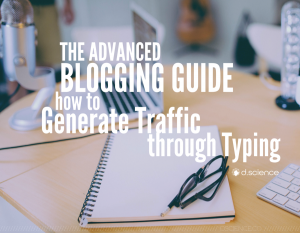
Social media has been around long enough that you’re already sold on the need.
But a complete social media marketing plan?
That’s a bit more complicated.
Luckily, one of the best parts of the modern age is that information is out there. Some of it is piece-meal, requiring you to search and cobble together a complete strategy. And some of it is complete.
This 11-Step Social Media Marketing Plan is the latter.
So let’s get rolling, so you can start growing your business.
Step 1: Determine Your Objectives
Before anything, you need to start slow. You need to ask yourself a serious question, and the answer might mean you stop reading this article.
Why are you going to invest serious time, energy and resources into social media?
And we’re talking a serious investment. In order to succeed on whatever platform(s) you choose, you can’t half-ass this.
It’s harder than ever to grow a social Following. Harder to get your brand and content seen in a social media world focused more on paid promotion than rewarding you for your efforts.
I don’t want to scare you, but I do want to make you aware of the realities.
Without paying for reach…
On Facebook, expect 2.5-5% of your Fans to see your Posts. On Twitter that jumps to 10-16% and Instagram and Linkedin will be around 20%. (Source: ElegantThemes.com)
The strategies you’ll see in the sections below will help, and Facebook advertising can actually be a money-saver (if you do it right and consider the time you’re spending).
But even so, know what you’re getting into, and know what you want to get out.
What do you want to get out of social media?
And the answer can’t just be “I’m on Social Media because I’m supposed to be.”
Main objectives:
- Increase Brand Awareness
- Drive Sales
- Generate Leads
- Create Community around your Brand
Identifying your goals of social media will inform your strategy for what platforms to be on, what to post and what metrics to track (which determines your return on investment).
Step 2: Decide your Platforms
Consider…
Time: How much time can you devote to a social network each week? Plan for around an hour per day per social network – and more in the growth stages.
Resources: Many social media platforms (Snapchat, Instagram, Pinterest) are visual in nature. Even Twitter and Facebook require some design to really capture the attention of users. Do you have those resources? What about a dedicated content team?
Audience: What does your target demographic look like? If you know, do you know on what social media platforms they hang out?
Step 3: Optimize your Profiles and Pages
Your social media Profile and Pages are an extension of your website. Everything there, despite being on someone else’s site, is yours. You’re responsible for it.
So, if it looks like a burning trash can, that’s on you.
A Page Optimization Checklist:
- Optimize your Headers and Profile Images
- Provide Complete Company Information
- Customize your Facebook Page URL
- Add a Facebook Page CTA
- Optimize for SEO
- Pin your Best Content or Limited-Time Promotions to Top
- Facebook Page Tabs
Social Media Image Sizes:
Step 4: Boost your Following
Ever wondered why that beggar on the street keeps a few coins in his hat at all times?
People are more likely to LIke something which has been Liked before.
This is why customer testimonials, good reviews, and influencer recommendations work. I don’t trust you unless someone has before me.
So, let’s boost your social following right out of the gate.
Social Promotions are still the best way to do this. You can spend the next couple months crafting content, but (speaking from experience) it’s almost impossible to build a social media presence from nothing. A foundation is key.
Sweepstakes
Facebook Sweepstakes promotions are great for first-time contest runners. They’re the simplest promotion type and are excellent for quick and simple lead generation.
Instagram Hashtag Contest
An Instagram Hashtag Contest asks Instagram users to post a photo onto the platform and tag it with a contest-specific hashtag. All pictures tagged with that hashtag are automatically grabbed and displayed in a gallery page on your website or Facebook Page (as well as on Instagram, of course).
Once images are in the gallery they can be voted upon and the photographers can spread the word about the contest and their submission (taking the hard work of promotion off your shoulders). The winner is whoever has the most votes on their submission.
Referral Promotion
Referral promotions work through incentivized sharing. Entrants share the contest with their friends, colleagues and family. Whoever gets the most people in their network to enter the contest wins the final prize, and everybody else gets a discount code incentive for entering.
Photo Contest
Fans or social media network users submit a photo and then share your contest with their friends, family and colleagues, asking them to vote (voters usually have to enter lead information, as well, by the way). This massively increases the spread of your promotion.

Top Tip: A great way to get more Facebook Fans for your Page is to add a “Like prompt” popup to your promotion’s page. This is within Facebook’s rules and regulations and simply asks people to Like your Page, but doesn’t require it (requiring contest entrants to Like your page before entering was abolished in 2014):

Social Media Contest Prizes
Summer Contests:
- Tickets to a sporting event
- Luggage set
- Camera with tripod stand
- Aquarium/Amusement Park/Zoo
- Camping Package
- $ 50 worth of photo prints
- Back-to-school gear: Backpack, pens and markers, calculator
- Sports team sponsorship
- E-reader
- Bike/skateboard/rollerblades
- Body wash prize pack including deodorant, soap, razors etc.
Winter Contests:
- Wearable tech (fitness trackers)
- Baking set – electronic mixer, whisks etc.
- Lift passes & ski rentals
- Christmas movie box set
- Ugly sweater Christmas party pack
- Professional lights decoration
- Holiday table set
- Apple Cider/hot chocolate/mugs
- Tickets to christmas events like the Nutcracker, christmas train, or garden of lights
- Gym membership/personal training session
Step 5: Get your Tone Right
People respond to people who sound like them (we’re tribal, at heart). People won’t respond well if your brand is super faceless, but nor will some markets respond if you’re overly casual.
Identify three characteristics you want your brand voice to embody. Keep these in mind when creating your content, coming up with your social media post copy and responding to Fans.
These “brand voice” characteristics should resonate with your target market:
- If you’re targeting mid-management professionals, use a professional tone and avoid memes, funny jokes, or puns – also avoid politics and world events.
- If you’re targeting professional millennials, be professional but also casual. Intersperse high-quality educational posts with current-event related content.
- If you’re targeting young people, post behind-the-scenes content with a casual voice. Post often and tap into Influencers (Step #7).
I love this table from Erika Heald on the Content Marketing Institute Blog identifying her three social media voice characteristics and how that’s reflected in her copy and the way she communicates on social media:

Step 6: Make your Social Content Calendar
Social media posting can be a complex thing. If you’re on multiple platforms, sharing a dozen times a day and your marketing team needs you to promote an upcoming webinar they forgot about until just now, where do you all fit it in?
This is where a social media content calendar comes in. It gives you an outline of what content is being pushed on which platforms, and when:

To access this social content calendar, just click here. If you make a copy you’ll be able to save it as your own and edit it however you like.
Many social media management platforms are structured in this way as well (more on that in Step 10), but I do know some social media marketers who still prefer their own tables as they can ensure they have everything they need and nothing they don’t. All in one place.
Be sue your content team is aware of the social media calendar, and visa versa. If they need something promoted be sure you’re aware of it, and if a holiday is coming up that you know you should capitalize on, make sure they’re creating something for you which is relevant.
Step 7: Identify your Influencers
Social media influencers can make or break your brand.
Getting “in with” a solid list of your industry’s leaders means brand awareness, content engagement, legitimacy and trust.
Think about it. If Seth Godin saw this article and Tweeted it to his 572,000 Twitter Followers what could we expect?
- A huge influx of traffic to the article, increasing its organic reach and (probably) SEO ranking.
- An increased awareness of me as an individual and Wishpond as a brand. The traffic driven to the blog would beget subsequent social shares and comments.
- An increased trust in me as an individual and Wishpond as a brand. Even if they don’t know me, they trust Seth, and if he trusts me that’s good enough for a huge proportion of his Followers.
And it works for every industry. Every single one has thought-leaders to whom people look for inspiration, thought-leadership and to “tell them what’s important.”
Rating Social Influencers
There are three ways to rate your influencers:
#1. Context: Does this person fit with my brand? Sure, Lady Gaga might have more than a few social media followers, but if she promotes your SEO consulting business will any of them care?
#2. Reach: Does this person have a network it would be valuable for me to reach? This can be size of network, but it can also be how passionate that network is about the subject. This score can also be increased based on the influencer’s expertise or the esteem they’re held in by the industry.
#3. Actionability: Will this person share my content? Are they receptive to communication or closed off and, despite their network, anti-social?
Identifying Influencers Through Social Media
- Search by hashtag, or Identify the hashtags that your target influencers are using.
- Put your influencers in a Twitter list so that you can organize and follow them most effectively
- Watch the “retweets” of Influencers to determine how “actionable” engagement with them might be.
- Watch their activity. How are they engaging with their Followers? Are they sharing other people’s content. How frequently, and what does the response seem to be?
Identifying Influencers Through Tools
Buzzsumo
Find and influencers through search. Analyze and filter them by reach, authority, influence and engagement. Follow directly within the platform and add to Twitter lists. Track their activity (what they share, how often, and where).

Traackr allows you to upload lists of Influencers, assign ownership to your team members, track conversations and engagement. Better though, Traackr makes it possible for you to identify the influence of your Influencers with a comprehensive analytics platform.

Incentivizing Influencers
- Do a blog trade. Write on their blog and ask them to write on yours.
- Trade promotion. If you have an email list, tell an influencer that you’ll share their content if they share yours.
- Include a link to an influencer’s content (helps them with SEO as well as brand awareness) and ask them where they’d like the link to send people.
- Pay for a Tweet.
- Pay for a guest contribution (on your blog) and a share with their audience.
- If you’re investing in Instagram, be prepared to pay. But it can be incredibly lucrative. Here’s an example of a sponsored post from fashion Influencer Louise Roe, a model and blogger from LA with 560,000 Instagram Followers:

Step 8: Find & Create Your Content
To succeed on social media, you can’t just publish the same cat photo over and over again, and nor can you consistently post promotional content.
Content sharing on social media is about two primary things…
1. Curated Content
Curated content is the stuff you find which is relevant to your business but
Sources for content to curate:
Influencer content is a great type of curated content. Many platforms (including Feedly and BuzzSumo) will allow you to “subscribe” to an influencer’s content publications.
Top influencer marketing strategy: Follow an influencer and then share their content with creative analysis and thoughts (and remember to @mention them when you do) for a few weeks. This will increase the chance they’ll follow you back and recognize your name when you reach out with a request for feedback or a quote or a “preferred link.”
2. Created Content
Create the content your Fans want to read. Ask yourself these five questions before starting any content strategy:
- What are they interested in?
- What are their pain points?
- What kind of content do they want?
- What is a confusing or complex part of your industry?
- What do they need to accomplish their goals?
For instance, Wishpond creates lead generation and management software. Our products are social promotions, landing pages and popups, as well as email marketing and lead management/behavioral triggered tools. Because of the social promotion side of what we do, a significant portion of our audience cares about social media marketing.
Thus, this guide. I create something which our prospective customers and target market need.
We’ve published more than 800 articles on the Wishpond Blog, writing since 2012. As the market has changed, so has our content. Right now, the market is fed up of piece-meal content which gives them half an answer. In order to stand out, we need to create high-value, long-form content which gives our readers everything they need to know in one place.
Step 9: Posting
When to Post
“The less people want to be at work [or working], the more they are on Facebook.” – Buddy Media (now part of Salesforce’ Marketing Cloud)
And this is true no matter what social media platform you’re on. Most people do most of their work in the three hours before lunch and the last hour before they leave. And most people do most of their work on Monday – Wednesday. As a result, many businesses find that the best time to post is 8-9:30am and then 1-4pm on Wednesday – Sunday.
Here’s a graphic from CoSchedule which lays it out:

Social Media Posting Best Practices:
- Target your Post (Facebook allows post targeting by location and interest)
- Tap into what people are thinking about with holidays & current events
- Share fan-created content
- Stick with the 80:20 rule – 80% educational, entertaining, fun content and 20% promotional (this can change if you’re in ecommerce).
- Use images in every post
- Use quotes
- Ask questions
- Use testimonials
- Tag influencers, users and other brands you like
- Be helpful
- Use Hashtags
- Use video (particularly on Facebook)
- Keep posts short
- Offer social media-exclusive Discounts
- Activate the comment section by starting the conversation and responding to comments
- Include a CTA
- Show behind-the-scenes
- Offer How-to guides
- Offer facts and trivia
- Try “fill-in-the-blank” posts
- Try “Caption this photo” posts
- Try “Remember when?” posts
Step 10: Tracking
There’s no point in doing any of this if you can’t track your results.
A great guide for tracking your social media metric is Hootsuite’s “7 Social Media Metrics that Really Matter – and How to Track Them” by Sarah Dawley.
Here are the five I’ve deemed the most important from her list:
1. Don’t just track link clicks, track click-through with bounce rate
Set up on Google Analytics or another analytics provider. Go to the “Acquisition” tab, and look under “All Traffic” for the “Channels” segment. Click on the “Bounce Rate” button and it should rank all of the channels from lowest bounce rate to highest.”
2. Don’t just track web referrals, track share of traffic driven
“Within Google Analytics, under Acquisition and Channels, click on the “Sessions” field. This will rank all of the channels based on the number of sessions they drive. In the column, beside the actual number, you should also be able to see a small percentage figure. This percentage represents the share of traffic being driven by each channel.”
Here’s a snapshot of Wishpond’s breakdown:

4. Don’t just track shares, track amplification rate
“Take the number of times your content was shared (or Retweeted, or repinned, or regrammed—or all of the above) during your reporting period and divide that number by your total number of followers (or Page Likes). Multiple that number by 100 to get your amplification rate as a percentage.”
5. Don’t just track likes, track applause rate
“Add up the total number of likes your posts received during your reporting period. […] Divide that number by the overall number of followers (or Page Likes). Multiple that number by 100 to get your applause rate as a percentage.”
6. Don’t just track numbers, track leads…
I’ll take this one, thanks Sarah!
Your social media Fans and Followers are just prospective customers who haven’t bought from you yet.
For many businesses, there’s a stage between Fan and sale – lead. You need to be getting these people’s email addresses. The view-rate (reach) of a Facebook post is 2% of your Fans, and the view-rate of an email is between 80 and 100%. The click-through rate on a Facebook post is about .05 and the click-through rate on an email is 20%.
For businesses not in the e-commerce industry, it’s going to be significantly easier for you to turn email contacts into sales than it is to turn Fans.
The best strategy for tracking prospective leads from social media is with a UTM code.
“UTM” stands for “Urchin tracking module.” Urchin Software Corporation was acquired by Google in 2005, and their software laid the groundwork for what we now know as Google Analytics.
UTM codes are bits of text you can add to a link that tell Google Analytics (as well as other analytics tools) a little bit more information about each link. Here’s a sample of what one looks like:”
(Source: Buffer)
Essentially, a UTM code allows you to see what link drove what traffic to a page of your website.
Google can help you make a UTM code here: https://ga-dev-tools.appspot.com/campaign-url-builder/
Step 11: Automate
Automation tools allow you to schedule your social media posts for multiple platforms and days in advance. They save you serious time and energy.
Social media management tools often include:
- Social media content calendar
- Analytics tools to make it easy for you to determine what content is working best and at what times
- Post templates
- Keyword-targeted content recommendations
- Social share toolbars to embed in your site
- Image and gif creators
- Link shortening and tracking
- Keyword alarms
The top social media management platforms with pricing:


 <
<


Wrapping it Up
Hopefully these 11 steps will start you on the road to success with social media.
No matter what platform you’re on, remember a few main things:
- Be social. Talk to your Fans. Ask them questions and respond.
- Invest in visuals. Stand out by being beautiful. Invest in a high-quality camera and try video.
- Post consistently. If you’re going to start on a platform and want to succeed on it, you need to stick with it. Social media success doesn’t come overnight.
- Test and Measure. If you’ve invested all this energy into being on social, don’t throw it away down paths which aren’t going to yield the return you want. If something isn’t working, you need to know, and you need to stop. Invest in analytics as much as you invest in Posting.
- Start with the 80:20 rule. Test the ratio and go from there.
(124)










